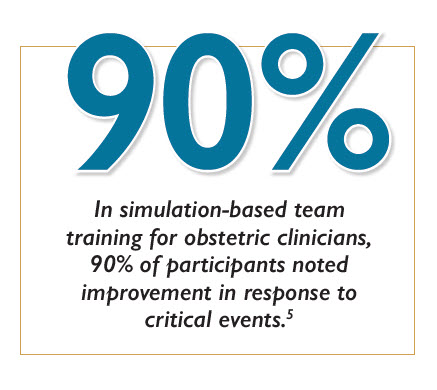
A collection of educational content
Resource Library
The Resource Library is a collection of educational articles, white papers, videos, infographics, and more.
Imagine yourself sitting outside your institution’s executive boardroom. You’re waiting to be called in to make your case for investing in medical simulation. You believe in the benefits of simulation. And, you’re passionate about what it can do. But at some point, you know you’ll be asked, “What’s the return on investment, the ROI?”
To stake your claim in that discussion, experts advise that you find common ground. This involves striking a balance between understanding what’s important to senior management, being clear about what you intend to deliver, and remaining firm about metrics that are important to solving the problem at hand.
To find that common ground and navigate the ROI discussion, follow these easy steps.
You don’t have to be a CFO to engage in the ROI discussion. What’s important is that you appreciate how a CFO thinks. A CFO’s job is to maximize investment outcomes for the benefit of the organization. The hallmark for how they approach this is the formula for ROI.

Experts advise, avoid viewing your CFO and senior executives as gatekeepers. Yes, they hold the key to something you want: money. However, you hold a key to something they want: gains in organizational performance. Now more than ever, senior management is seeking solutions to achieve better performance. If you define your gains correctly, you will increase your chances of making the ROI discussion a collaborative one.
Return on investment in simulation is not necessarily about bringing in money… what it does is save money.
As you focus on gains, help your CFO and senior management understand the problem as you see it. What pain point are you trying to solve with simulation? Why do you need to solve that pain point now? What happens if you don’t? Why should anybody care? Communicate the problem that your organization faces in real-world terms.
Answering the above questions will allow you to create a persuasive problem statement that you can use to spark interest in your project. Here’s a mock example from an attending obstetrician responsible for a labor and delivery department:
Refine this statement to reflect your own clinical field and circumstances, but don’t lose the essence of what you are experiencing in your real-world environment which others may rarely see.

The more complex your simulation design, the more difficult it will be to justify how everything connects to the gains you’ve identified. Most experts advise that you should keep your projects simple—especially if you’re new to simulation. Think about your metrics first and ensure that your simulation design fits how you define success.
The following list can become quite complex if you let it:
“The justification of simulation is about the goal and the metrics you’re using to measure your day-to-day success,” explains Dr. Amar P. Patel, Director of the Center for Innovative Learning at WakeMed Health & Hospitals. At the end of the day, we’re here to help learners be more competent and confident in their skills. And we’re here to keep our patients safe.”
Simulation does not have to be complex to achieve this. Match your design to your metrics.
You understand and can explain the problem. You’ve created the solution. Now you can answer what your organization stands to gain. Will it be reduced risk? Improved patient satisfaction? Mission achievement? Better nurse retention? Better employee engagement?
A joint report from the American Association for Physician Leadership® and HFMA suggests that many gains fall under the general topic of helping build a high-reliability organization.3 Drawing on their recommendations, consider outlining your gains in terms of patient safety, quality, patient satisfaction, and financial margin. If your solution leads to positive gains in any of these categories, you’ve now touched on areas where senior management is likely to focus. The good news for you is that you may be the first ever to introduce them to simulation as a solution.
Continue to keep your CFO involved, and broaden your support base. Reach out to decision-makers and ask for their help. Invite them to see and experience the problem you seek to solve. Arrange for them to participate in a simulation and show them how simulation addresses the problem in a way no other solution can.
According to Joe Fifer at HFMA, “As a hospital CFO I saw great ideas daily. The ones that really got my attention and commitment were sponsored by people who got me actively involved so I could experience the problem first hand, sometimes even at the patient’s bedside.”
Get key stakeholders to come and put their hands on a manikin and experience that adrenaline rush when they’re doing chest compressions (or) delivering a baby.
By getting members of your senior management involved, you’ll be presenting to an audience that already feels some ownership of the problem and are more likely to view your efforts as a problem-solving session rather than a bid for funding.
Time is money. And to upper management, the longer one has to wait for ROI, the more risk is involved.
Experts in simulation turn to the Kirkpatrick model4 to demonstrate gains as learners go deeper into simulation. This model is based on a four-step progression that allows you to show how simulation training is worth the investment:

One of the biggest challenges facing most senior management is employee engagement. Be prepared to show them how simulation meets that challenge head-on (See 3 Ways Simulation Can Help Accelerate Your Learning Efforts].
The whole basis for the Kirkpatrick model is how employee engagement equates to ROI – showing, in practical, no-nonsense terms how simulation can deliver immediate value.
Here’s where you get to put it all together and make a powerful case for investing in simulation.
By getting your CFO and other key stakeholders involved early in the process, you’ll be confident in framing the discussion in terms that they can understand and appreciate.
Your senior management’s ultimate goal is to implement solutions that advance the functions of your institution—while giving them the greatest ROI. You know the advantages of simulation training. And now you have the background to effectively present your case.
Sign up for Laerdal Medical email updates. You can identify your interests and receive new educational content, updates, event information and more.